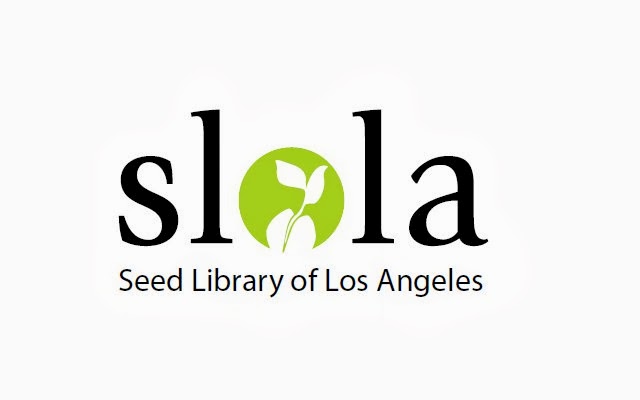The
idea of a 'seedshed' first came to my attention via Cris Franco,
founder of the Rio Salado Seedshed Library (and of www.sewapermaculture.com) in Phoenix. To me, it was easy
to grasp the significance of a 'seedshed' and quickly see that
SLOLA's seed library model was in direct contrast to a seedshed.
The
term 'seedshed' takes it's cue from a 'watershed.' You also see the
concept showing up these days in the term, 'foodshed.' They all come
from the concept of trying to define what is local and what's not. A watershed denotes a
commonality in water resources. Water draining the same direction,
along a given slope, is a watershed. There is commonality therefore a case
can be made that water conditions within a watershed are similar and
consequently 'local.' Seeds grown in common weather, rainfall and soil
would comprise a given seedshed and therefore be local to one another.
 |
| Cris Franco tabling at her Rio Salado Seedshed Library |
In
contrast, the Seed Library Of Los Angeles embraces the entire greater
Los Angeles area and a quick glimpse at the Sunset Western Garden
Guide's Zone map shows we cover several seedsheds with some fairly
different seedsheds included. Never mind that they are only a few
miles apart, conditions from one to the other can be different enough
to not allow for local adaptability which is a hallmark of being a
seed saving gardener.
I'm
sure Sunset would have a cow if I reprinted the LA map here, but the book is ubiquitous enough you can find it at a
library or pick up a copy locally or on Amazon. Their website has this representation, although before you go there, please be advised the pop-up ads are more than just annoying. Even though Sunset is
primarily concerned with growing ornamentals, the book is a valuable
resource for all west coast gardeners if only for the information it
gives on the 24 zones delineated along the west coast.
Los
Angeles, running between Zones 18 to 24, with each zone constituting what
Cris would consider it's own seedshed. Zones 18 and 19 are interior
climates, having less ocean influence, while Zones 20 and 21 are
influenced by the ocean as well as the interior climate. Zone 22 is
the cold winter portion of our area, while zone 23 is the thermal
belt of the coast. Then there is Zone 24, in which the actual
library itself is located, which Sunset defines as almost completely
dominated by the ocean.
Each
one of these zones, then, is its own seedshed and should save seeds
for itself; in fact, there are probably different seedsheds within
some of the larger areas of the zones. Zone 24 extends along the
coast North past Santa Barbara and south beyond San Diego. While
there is a lot of commonality between Santa Barbara and San Diego, I
don't know if we can put them in the same seedshed. Zone 23 around
Whittier might have a lot in common with Zone 23 at the Pacific
Palisades, but I can handily see they might comprise different
seedsheds.
I
see a lot of diversity in these areas and a lot of compromising of
seedsheds. But SLOLA has an answer and already we are moving to
implement a system of 'branch libraries' under the SLOLA umbrella.
The San Fernando Valley Branch of SLOLA will open this Friday (on
International Seed Day, by the way) and will begin to steward seeds
that will be most at home in their 18, 19 and 21 zones. Their
initial inventory will be the same as the original library, but over
time will diverge and each library's inventory will take on different
characteristics, adapting to the different climate and soils. The
two will not be totally dissimilar, but will diverge somewhat over
time. Seeds, left to their own devices, will always be local to the
place they are grown over time. This is one of the ways that open
pollinated seeds and not nationally produced hybrids adapt and are
therefore better for the grower. Remember, seeds are local and many
of the open pollinated heirloom seeds are local to the east coast or
the mid-western states and therefore are often a disappointment to
Los Angeles gardeners. If we want a local tomato, it will be up to
us to grow it!
The
two inventories provide a duplication we have always wanted. It has
never been our intent to store all our seeds at one location – any disaster could wipe out our entire stock of seed, setting
SLOLA back years. So having two inventories near each other
is a valuable asset. Of course, we hope to do more – Long Beach
and Eagle Rock have both expressed interest in having a branch and we
hope to accomplish that this year or next.
On International Seed Day, residents of the Valley can gather to
inaugurate their own library. The first meeting of the San Fernando
Valley branch of the Seed Library Of Los Angeles will take place on
Friday, April 26th, at 1 pm at the Sepulveda Garden Center, 16633
Magnolia Blvd, Encino, CA 91436.
No
need to RSVP. Just come on out and
take home a seed to steward into a truly local seed to feed your
family and the families of those warmer Sunset Zones!
david
